If you take really good care of your roof, it can take really good care of your home. In fact, it can hold up admirably for about 20 to 25 years before you need to have a roof replacement. But all kinds of unexpected events and circumstances can happen that can inflict damage on and shorten the life of your trusty, silent, protective roof. And when that happens, damage (particularly water damage) can seep in and trickle down to damage other parts of your home’s structure. This is why it’s so important to check your roof for any wear and tear on a regular basis. We suggest having a regularly scheduled roof inspection in the spring (to assess how it endured the winter storms) and in the fall (to see if it held up under the hot summer and its wild weather).
Also check for damage after any extreme weather events. It’s much easier and less expensive to make small roof repairs promptly than to have to make big roof repairs or prematurely have to replace the entire roof and repair other damaged areas. Follow this roof inspection checklist for homeowners, and if you see anything suspicious, call Affordable Quality at (703) 794-8513 to have it checked out promptly.
NOTE: This Roof Inspection Checklist is safe for homeowners to perform on their own from the ground, using binoculars. For safety reasons, contact us if there is anything you see from your visual inspection that requires climbing a ladder to get a closer look!
- Go Inside First. Check up in the attic, in crawl spaces, on the top floor and around the exterior walls and ceiling areas for any water stains. Also check around dormers and chimney spaces because those are areas vulnerable to water infiltration during bad weather. Dampness, puddles and dripping are dead giveaways for leaks.
- Check gutters and downspouts for granules from the shingles.
This is an oft-forgotten, but important piece of the roof inspection checklist. Some granule erosion is normal over the life of the roof, so you will see some there even on a normal day. But check regularly and see if you notice a sudden increase in the amount of granules wearing off, because that means the shingles are starting losing their effectiveness at protecting your roof from the elements. - Visually inspect the shingles. You can use binoculars to get a better look without climbing up. If you notice any of the following, it’s time to call for help:
- Broken or missing shingles—As shingles age, they can become brittle enough that a stiff wind or ice may break them right off, making your roof vulnerable to the elements.
- Cupped or buckled shingles—Bad ventilation in the attic can lead to overheating that will cup or buckle shingles, making it possible for water to get in and cause damage.
- Flapping shingles—Check your roof on a windy day sometime soon and see if any shingles are flapping. If so, the adhesive sealant strips that attach the shingles to the roof may be losing power and letting in water, which is never a good thing.
- Check for flashing damage. The flashing is a thin, waterproof layer of material that keeps water from penetrating at any seams in the roof, such as roof valleys, around chimneys, vents, roof hips and joints. The flashing covers vulnerable spots and directs water away from them. Sometimes severe weather or other conditions might damage the flashing, causing water to leak in. So periodically use your binoculars to check that the flashing is all right.
If you go through this roof inspection checklist and uncover any of these issues, call us right away. The faster any issues can be resolved, the longer your roof will last. Help your roof protect the rest of your home and family for as long as possible!
Call us at (703) 794-8513 today if your roof needs help!

